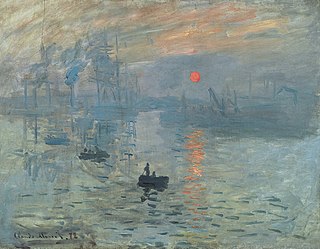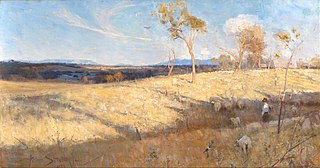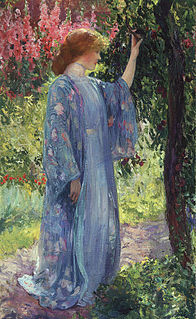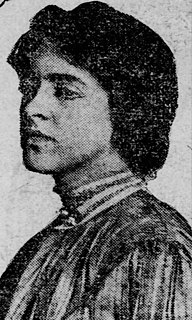Related Research Articles

Impressionism is a 19th-century art movement characterized by relatively small, thin, yet visible brush strokes, open composition, emphasis on accurate depiction of light in its changing qualities, ordinary subject matter, inclusion of movement as a crucial element of human perception and experience, and unusual visual angles. Impressionism originated with a group of Paris-based artists whose independent exhibitions brought them to prominence during the 1870s and 1880s.

Post-Impressionism is a predominantly French art movement that developed roughly between 1886 and 1905, from the last Impressionist exhibition to the birth of Fauvism. Post-Impressionism emerged as a reaction against Impressionists' concern for the naturalistic depiction of light and colour. Due to its broad emphasis on abstract qualities or symbolic content, Post-Impressionism encompasses Les Nabis, Neo-Impressionism, Symbolism, Cloisonnism, Pont-Aven School, and Synthetism, along with some later Impressionists' work. The movement was led by Paul Cézanne, Paul Gauguin, Vincent van Gogh, and Georges Seurat.

The Heidelberg School was an Australian art movement of the late 19th century. It has latterly been described as Australian impressionism.

The Barbizon school of painters were part of an art movement towards Realism in art, which arose in the context of the dominant Romantic Movement of the time. The Barbizon school was active roughly from 1830 through 1870. It takes its name from the village of Barbizon, France, on the edge of the Forest of Fontainebleau, where many of the artists gathered. Most of their works were landscape painting, but several of them also painted landscapes with farmworkers, and genre scenes of village life. Some of the most prominent features of this school are its tonal qualities, color, loose brushwork, and softness of form.

Julian Alden Weir was an American impressionist painter and member of the Cos Cob Art Colony near Greenwich, Connecticut. Weir was also one of the founding members of "The Ten", a loosely allied group of American artists dissatisfied with professional art organizations, who banded together in 1898 to exhibit their works as a stylistically unified group.

In art history, Secession refers to an historic break between a group of avant-garde artists and the conservative European standard-bearers of academic and official art in the late 19th and early 20th century. The use of the term "secession" to describe young pioneers artistically migrating from the "old country" to create a new one was almost certainly inspired by the history of annexation, secession and dissolution in the city-states of Central Europe. Credited to Georg Hirth (1841–1916), the editor and publisher of the influential German art magazine Jugend (Youth), which inspired the Jugendstil, he used the term "secession" to emphasize the painful rejection of legacy art and the fits and starts of a splinter group forging a new "school" of art.

Charles Cottet (1863–1925), French painter, was born at Le Puy-en-Velay and died in Paris. A famed post-impressionist, Cottet is known for his dark, evocative painting of rural Brittany and seascapes. He led a school of painters known as the Bande noire or 'Nubians' group, and was friends with such artists as Auguste Rodin.

Edward Willis Redfield was an American Impressionist landscape painter and member of the art colony at New Hope, Pennsylvania. He is best known today for his impressionist scenes of the New Hope area, often depicting the snow-covered countryside. He also spent his summers on Boothbay Harbor, Maine, where he interpreted the local coastline. He frequently painted Maine's Monhegan Island.

Paul Durand-Ruel was a French art dealer associated with the Impressionists and the Barbizon School. Being the first to support artists such as Claude Monet, Camille Pissarro, and Pierre August Renoir, he is best known for his innovations in modernizing art markets, and is generally considered to be the most important art dealer of the 19th century. An ambitious entrepreneur, Durand-Ruel cultivated international interest in French artists by establishing art galleries and exhibitions in London, New York, Berlin, Brussels, among other places. Additionally, he played a role in the decentralization of art markets in France, which prior to the mid-19th century was monopolized by the Salon system.

Florence Helena McGillivray, was a Canadian landscape painter. Though McGillivray's main talent lay in landscape painting, she also practiced painting in watercolour during her career. Her paintings depicted many locations on the Gatineau River, the Val-des-Bois, the Ottawa River at Fort-Coulonge and many more scenes of Canada and abroad.
Henri Cadiou was a French realist painter and lithographer known for his work in trompe-l'œil paintings. He is credited with being a founder of the l’école de la réalité in 1949. 'De la Réalité' was reaction against abstract art, seen at the Salon de Mai of 1960 where he exhibited paintings that were almost photographically realistic, in particular Shower Curtain and Electoral Panel, with which he caused a stirReacting against abstract art. He was also president of the Association for the Protection of the Cité Fleurie, a wooded area around the boulevard Arago in Paris's 13th arrondissement where about thirty artist’s studios are located. Through his extreme realist style, Cadiou created trompe-l'œil paintings by grouping together large numbers of everyday objects. He also painted genre scenes. Some of Cadiou's most famous works are 'Le mégot, 1971' and 'Handel with Care, 1996'
Bande noire can refer to:

Lucien Joseph Simon was a French painter and teacher born in Paris.

The terms California Impressionism and California Plein-Air Painting describe the large movement of 20th century California artists who worked out of doors, directly from nature in California, United States. Their work became popular in the San Francisco Bay Area and Southern California in the first three decades after the turn of the 20th century. Considered to be a regional variation on American Impressionism, the painters of the California Plein-Air School are also described as California Impressionists; the terms are used interchangeably.

Decorative Impressionism is an art historical term that is credited to the art writer Christian Brinton, who first used it in 1911. Brinton titled an article on the American expatriate painter Frederick Carl Frieseke, one of the members of the famous Giverny Colony of American Impressionists, "The Decorative Impressionist."
Despite its size, Belgium has a long and distinguished artistic tradition that goes back to the Middle Ages, considerably pre-dating the foundation of the current state in 1830. Art from the areas making up modern Belgium is called in English Netherlandish up to the separation with the Netherlands from 1570 on, and Flemish until the 18th century.

Helga Cathrine Ancher (1883–1964) was a Danish painter. As the daughter of Anna and Michael Ancher, she was closely associated with the Skagen Painters. Most of her paintings were of her family and friends in Skagen and of local landscapes.

Mary Smyth Perkins Taylor (1875–1931) was an American Impressionist painter and fabric artist. She was a member of a group of artists centered in Bucks County, Pennsylvania known as the Delaware Valley group, or the Pennsylvania Impressionists.

René François Xavier Prinet was a French painter and illustrator who drew his subjects from middle-class society.
References
- 1 2 Turner (ed.), Jane (2000). The Grove Dictionary of Art: From the Renaissance to Impressionism. Macmillan. p. 32.CS1 maint: extra text: authors list (link)
- ↑ Van Santvoort, Linda, Jan De Maeyer, and Tom Verschaffel. Sources of regionalism in the nineteenth century: Architecture, art, and literature. Vol. 9. Leuven University Press, 2008, p. 170.